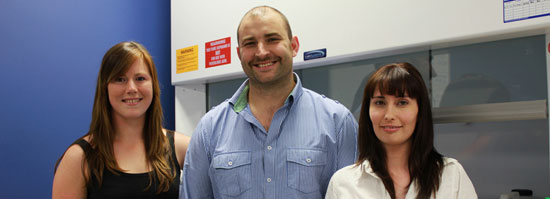 While pinning up posters may seem mundane, in the scientific and academic community its really all about publishing papers and pinning up posters.
While pinning up posters may seem mundane, in the scientific and academic community its really all about publishing papers and pinning up posters.Hence the delight of everyone connected with Australia’s Pork Cooperative Research Centre (CRC) when two of its youngest and brightest, Robyn Terry and Alice Weaver, won poster competitions at the recent inaugural Research Day held by the University of Adelaide School of Animal and Veterinary Sciences at its Roseworthy, South Australia campus.

After being judged on scientific content and presentation by an independent panel of four senior academics, Ms Terry was awarded best post-graduate student poster (out of 23) and Ms Weaver best honours student poster (out of 8).
Pork CRC Education and Training Program Manager, Dr Will van Wettere, a lecturer in intensive livestock at the School of Animal and Veterinary Sciences, supervised their honours projects and now supervises their Pork CRC supported PhDs.
According to a delighted and proud Dr van Wettere, Ms Terry’s poster was based on her first PhD experiment, investigating the effects of suckling load on incidences of lactation oestrus.
Ms Weaver’s poster was on her honours projects, determining the effects of lupin fibre on oocyte (egg) developmental competence.
She noted that improved oocyte nuclear maturation, in the absence of any change in reproductive hormones, suggested the effect of lupins on ovarian function was independent of gonadotrophins.
According to Dr van Wettere, while Ms Weaver’s honours project demonstrated that oocyte quality in gilts was affected differently by varied fibre sources, necessary further studies would determine how feeding lupins influenced oocyte developmental competence and if lupin based diets improved embryo survival and litter size.
“Her PhD will investigate the effects of nutrition and season on ovarian function and embryo development,” Dr van Wettere explained.
Ms Terry’s award winning poster, ‘The effect of split weaning on the timing of oestrus relative to weaning and piglet growth’, summarised her hypothesis that split weaning (removing a portion of a litter) 18 days after farrowing would enable ovulation and oestrus to occur before full weaning.
“While acknowledging that sow reproductive output can be maintained by stimulating a behavioural oestrus and ovulation during lactation, my preliminary data suggests that to express oestrus during lactation sows don’t need a reduced suckling load, provided they have boar contact,” Ms Terry said.
By day 40 there were no significant differences in piglet liveweight, indicating that split-weaning may have improved the performance of light-weight piglets resulting in growth performance comparable with heavy-weight piglets
Increasing piglet weaning age to improve growth and survival is only commercially viable if the number of piglets weaned/sow/year is maintained.
Those wanting more details of Ms Terry’s and Ms Weaver’s research should visit Pork CRC's website www.porkcrc.com.au
Meanwhile, applications for Pork CRC Honours Awards close December 3.
The Pork CRC’s Education Committee will consider all completed applications at a meeting in mid-December. The nomination form can be downloaded at http://www.porkcrc.com.au/Honours_Award_application.doc



